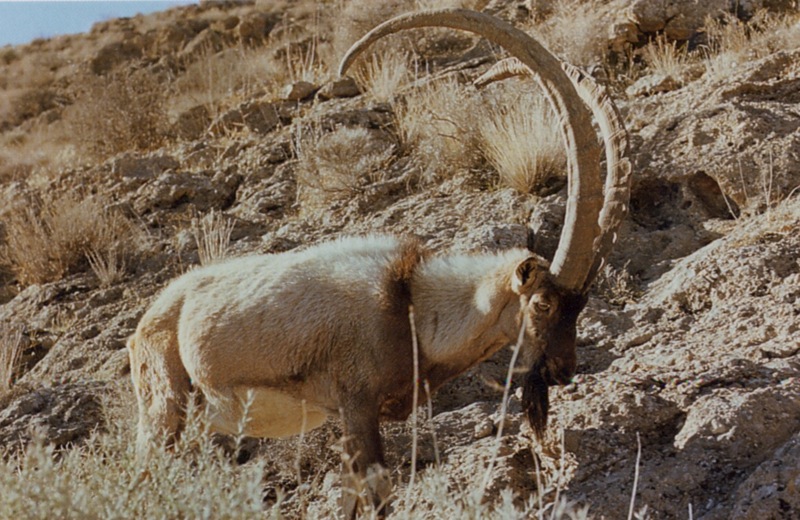
Local name: Sarah (Sindhi: Sind)
Description and Biology:
Size:Body Length: 1.3-1.4m / 52in from nose to tip of tail.
Shoulder Height: 85-95cm / 33.5-37.5in.
Tail Length: 12-15cm / 4.75-5.75in.
Weight: 45-90kg / 99-200lb.
Description: Sind Ibex are rather stocky animals with thick-set bodies and strong limbs terminating in broad hooves. Female and young males, till their second winter, are yellowish-brown variying to reddish-grey with a darker brown mid-dorsal line extending from between the shoulders to the base of the tail. Mature males are spectacularly beautiful, with long sweeping scimitar shaped horns over 102cm (40in) in length and almost silver white bodies offset by a sooty grey chest, throat and face. The extent of white hairs in the hind neck and body region of males increases with age. The hair in summer coat is short and coarse and even in adult males is more reddish-buff in colour. Males have shorth beards, but females lack any beard. The belly and outside of the lower limbs, beard annd forepart of the face vary from balck to deep chestnut-brown in mature males. There is also a conspicuous black stripe in adult males, running from the wothers down the front of the shoulders and merging with the black chest. Older males have a dark face pattern. The horns are strongly keeled in front, sweeping upwards and outwards witht the tips generally diverging.
Reproduction: Gestation Period: 150 to 155 days. Young per Birth: 1, but twins are common. Mating occurs between October and December, with the young being born from April to May. Weaning: After seven to eight months. Sexual Maturity: At 3 years.
Social Behavior: This wild goat is gregarious, and if undisturbed will congregate in fairly large herds. The older male associate with such herds but generally keep together, often on the periphery of the main band. Where disturbed, they are much more wary and ascend into inaccessible crags very early in the morning, emerging again just before dusk. During the hottest part of the year, they lie up more extensively during the day and may graze a considerable part of the night. Wild goats have a wonderfull sense of balance and can make a standing leap 1.75m (5-6ft) upwards on a seemingly vertical rock surface. They appear almost slow and deliberate when traversing rock faces but can slide without injury down almost perpendicular rock faces with drops as much as 4-6m. When challenging another male these wild goats frequently stand up on their hind legs and at the same time bend their head to one side before charging forward and clashing their horns.
Diet: The will browse the leaves and bushes as well as small shrubs and forbes. Many observers believe that they can exist indefinitely without drinking water (all above information from ” The Mammals of Pakistan” by T.J Roberts).
Habitat and Distribution:
Wild goats can survive almost at sea level and in fact do so in some of the remorter cliffs around Ormara. They inhabit mountain crests up to 3, 350m. Wild goats are found in all the higher and more extensive mountian ranges of southern Baluchistan from the Mekran coastal range at Pasni right across Sindh Kohistan and the Kirthar Range in the east. They are also found in Kalat. There is a game reserve for ibex in the Hingol Range in central Mekran. The biggest population of this wild goat is in Kirthar National Park in southern Sind. There have been many census carried out and Sind Wildlife Department puts the total number in Kirthar National Park at around 4,000 ( Kirthar National Park guidebook ). A helicopter survey conducted in November 2000 by the staff of the Sindh Wildlife Department, Zoological Survey Department and the University of Melbourne yielded estimates of the total populations of the Sindh ibex at 13,155 ± 2460, and concentrated on the Khirthar Range, with lower concentrations on Khambu and Dumbar and small numbers elsewhere. (all above information from ” The Mammals of Pakistan” by T.J Roberts and “Baseline Environmental Study of Kirthar National Park”, Sind Wildlife Department ).
